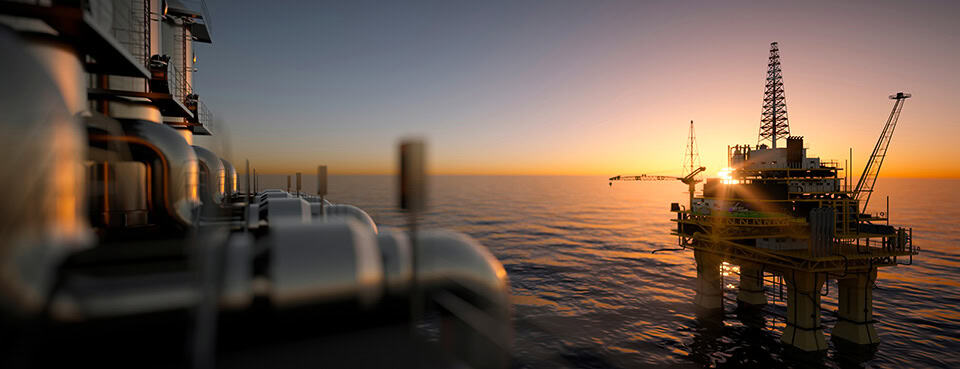Imagine you’re miles offshore, surrounded by nothing but the open ocean and the hum of operating equipment. Out here, your process systems must battle saltwater corrosion, extreme weather, and tight space constraints—all while keeping operations running safely and efficiently. Offshore heat exchangers and industrial heating systems must withstand constant exposure to corrosive elements, intense conditions, and demanding operational challenges. With the right engineering approach, offshore heating solutions can deliver reliable performance while mitigating safety risks.
Today, we’re diving into key offshore design considerations and how Enerquip’s expertise helps navigate the process with tailored solutions for offshore operations.
Designing for Reliable Performance in Marine Environments
Offshore installations face ongoing exposure to corrosion from the surrounding saltwater and humid air. Selecting the right materials is a critical step in designing a system that can withstand these conditions long-term. Materials like 316L stainless steel, duplex stainless steel, and titanium are top contenders due to their resilience in harsh, corrosive environments. Titanium, in particular, stands out for its exceptional corrosion resistance after prolonged exposure to seawater.
Corrosion-resistant heat exchangers utilize materials like these to offer long-term durability and reliability in offshore applications.
Key Environmental Considerations
Offshore heat exchanger and industrial heater designs must be robust enough to withstand high winds, heavy rainfall, and extreme temperatures. Protective measures, such as NEMA 4X-rated control panels for industrial heating systems, are important to ensure reliable outdoor use. Further, designing with temperature fluctuations in mind and incorporating splash protection helps extend equipment longevity.
Efficiency and Heat Loss Mitigation
Smaller, more efficient designs are often necessary to accommodate space and weight constraints. Helical coil thermal fluid heaters are a prime example of compact, efficient equipment designs that can meet the unique design requirements of offshore applications. These conserve space and reduce the structural load on platforms, effectively addressing size and weight concerns.
Insulation is another important design factor to consider. Offshore conditions like high winds and cold temperatures can sap heat, hindering the system’s efficiency. High-performance insulation can help protect equipment from these conditions, improving overall thermal efficiency by capturing and reusing waste heat.
Power Supply and Safety Considerations
Offshore platforms often operate with limited power generation capabilities. Incorporating backup power supplies and fail-safe mechanisms is crucial for maintaining operations during outages. Additionally, emergency shutdown features prevent accidents and system damage.
Implementing these in heater designs keeps operations running smoothly in offshore environments and strengthens overall system reliability.
Explosion Protection
The presence of flammable gases near oil and gas rigs calls for stringent explosion protection measures. Equipment must meet standards such as:
- ATEX (Europe) – For explosive atmospheres
- IECEx (International) – Globally recognized certification
- NEC Class I, Division 1/2 (USA) – Defines hazardous locations
Using explosion-proof components with heavy-duty insulation materials is important to maintain a safe operating environment. You’ll also want to make sure that all electrical systems are appropriately rated for use in hazardous areas.
Maintenance and Accessibility
Regular maintenance in offshore environments can be challenging. Designing equipment with easy-access features like removable panels and quick-connect systems makes maintenance work easier to complete. Additionally, incorporating remote monitoring capabilities allows for early detection of issues, which minimizes downtime and maintenance expenses.
Environmental Compliance
Strict environmental regulations govern offshore installations, especially concerning emissions and discharges. Ensuring equipment meets these standards is vital to both legal compliance and marine ecosystem protection.
Key strategies for environmental compliance:
- Design systems to minimize emissions
- Implement leak-prevention technology
- Use efficient fuel sources to lower environmental impact
Enerquip’s Expertise in Offshore Thermal Solutions
Navigating the complexities of offshore heating solutions requires a partner with specialized knowledge and experience. Enerquip stands out in this arena, offering tailored solutions that address the unique challenges of offshore environments. From corrosion-resistant materials to compact designs and energy-efficient systems, Enerquip’s offshore heat exchangers and industrial heaters are designed to meet the rigorous demands of offshore applications.
If you’re looking to optimize your offshore heating systems or need guidance on selecting the right equipment, Enerquip’s team is ready to help. Contact us for more information or request a quote to get started.
More from the Enerquip Blog
- Glycol Dehydration: Removing Water for Safer Natural Gas Transport
- Nitrogen Blanketing in Thermal Fluid Heating Systems
- The Case for Waste Heat Recovery: Why Your Facility Shouldn’t Ignore It
- Why Investing in High Grade Heat Transfer Fluid is a MUST
- How Economizers Enhance Thermal Oxidizers
- Five Ways to Increase Terminal Efficiency

